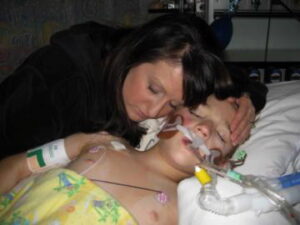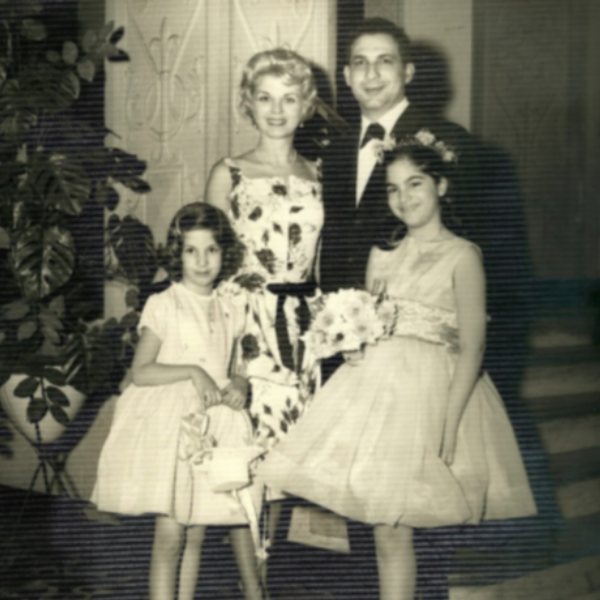On Friday, October 30th 2009, my son Nathan had just turned ten. The next day, October 31st, he played in an early morning football game. I noticed he wasn’t running as fast as usual, and wasn’t giving it his all during that game. But I thought nothing of it, assuming he was just worn out after a busy day.
We got home that afternoon and prepared to go out trick or treating later around the neighborhood. By the time evening came around Nathan was feeling sick—so sick, in fact, that he decided to stay home from trick or treating that night. At that point I knew he was really not feeling well and assumed it was a bad cold or possibly even the flu. My husband and I even joked that maybe he had the “swine flu.” It had been on the news several times that year that people were coming down with a new strain of flu called the swine flu, and it seemed to me everyone was making a big fuss about something that wasn’t that big of a deal. You get the flu, stay sick for a day or two and then get better right?
While Nathan’s sister went out trick or treating, I stayed home and thought maybe I could pull out some natural remedies to ease his symptoms; it didn’t cross my mind to see a doctor at this point. The next day was a Sunday, November 1st. I had gone to work for the evening ready to pull a graveyard shift, and got a call a few hours later from my husband telling me I needed to come down to the hospital right away. Nathan had been admitted for trouble breathing.
As soon as I got to the hospital, I saw that Nathan had been given an oxygen mask and was being taken for chest x- rays. I asked the doctor what was happening and she told me “You’re son is very, very sick right now.” The ER doctors decided that he should be moved to the PICU unit of the hospital “just in case.”Not knowing what that meant, I asked my husband (who had worked for an architectural firm that designed hospitals) why Nathan was being moved to this unit and he told me it was in case Nathan needed to be intubated.
 Nathan was moved to the PICU immediately after coming back from his x-rays, and sure enough, within probably less than two hours the decision to intubate him was made. He had stopped breathing on his own. His lungs and his chest cavity were rapidly filling with fluid. Suddenly, a team of doctors came into the room, along with a social services representative, and told us Nathan had a life-threatening illness and that we needed to make arrangements to stay at the hospital overnight.
Nathan was moved to the PICU immediately after coming back from his x-rays, and sure enough, within probably less than two hours the decision to intubate him was made. He had stopped breathing on his own. His lungs and his chest cavity were rapidly filling with fluid. Suddenly, a team of doctors came into the room, along with a social services representative, and told us Nathan had a life-threatening illness and that we needed to make arrangements to stay at the hospital overnight.
I was confused, I thought all he had was the flu? I had no idea the flu could be life-threatening.
My son spent the next seven days sedated and intubated in the PICU, with two collapsed lungs, unable to breathe on his own. These seven days were excruciating. We did not know if Nathan would make it out of the hospital alive.
By the eighth day, Nathan finally showed some signs of improvement. The doctors determined that Nathan needed to be taken off the ventilator if he was going to ever have a chance to breathe on his own again. It was heartbreaking to watch Nathan lying there disoriented and scared. I remember him seeing me above him, and trying to say “Mom” several times as the doctors and nurses prepared for the removal of the tube. And yet he couldn’t say it, because the tube was still in place.
Finally, after about eight hours, he was stabilized and breathing on his own after a scary intense incident where his heart rate plummeted after being given morphine for the pain that ensued. Come to find out he is like me and reacts negatively to opiates.
 For the next month and a half it was an emotional roller coaster. We literally lived at the hospital within a separate building for parents whose children are in life-threatening situations and can’t leave the hospital. Nathan suffered through chest tube after chest tube being inserted into his side, a total of seven. He had three major surgeries on his chest cavity to remove fluid that threatened to flatten his lungs. He had daily chest x-rays and multiple CT scans. We continued to hear scary medical terminology each time his doctors came to talk to us, words like “staph infection”, “empyema”, “ruptured lung abscess”, “chylothorax”, and “secondary infections”. The doctors even suggested testing him for cancer at one point, because they were baffled at why a healthy, active child with no prior medical issues had an immune system that tanked so suddenly.
For the next month and a half it was an emotional roller coaster. We literally lived at the hospital within a separate building for parents whose children are in life-threatening situations and can’t leave the hospital. Nathan suffered through chest tube after chest tube being inserted into his side, a total of seven. He had three major surgeries on his chest cavity to remove fluid that threatened to flatten his lungs. He had daily chest x-rays and multiple CT scans. We continued to hear scary medical terminology each time his doctors came to talk to us, words like “staph infection”, “empyema”, “ruptured lung abscess”, “chylothorax”, and “secondary infections”. The doctors even suggested testing him for cancer at one point, because they were baffled at why a healthy, active child with no prior medical issues had an immune system that tanked so suddenly.
Nathan was finally discharged from the hospital and sent home with a PIC line in place on November 27th only to be readmitted on December 1st due to high fever and fluid building up once again in his chest cavity. He stayed for another fifteen days before doctors determined he was well enough to go home on December 15th. He was given a flu shot, as was the entire family, before leaving the hospital this time. None of us had ever received a flu shot prior to this and the doctors explained that it would help protect against additional flu viruses that were out there and that if he was to get another case of influenza after being discharged with his immune system in its current condition it could be devastating.
Lab results eventually came back and confirmed Nathan had an aggressive strain of H1N1 influenza, which lead to his initial diagnosis of pneumonia. Following his second discharge from the hospital were multiple visits to the doctor’s office for testing and x-rays to make sure he was continuing to heal and improve, and eventuallym on January 11th, 2010, we got the slip from his doctor that read “No restrictions, may return to school.” It felt like the greatest day of my life!
Today I cringe when I hear parents say “I would rather my child get the flu than the flu shot” or “I’ll take my chances with the flu rather than inject ‘toxins’.” I wouldn’t wish the flu on any child! I won’t take my chances again, never ever again. Our family has received the annual shot for influenza each year since and I am happy to say we have been healthy ever since! My hope is that my story will encourage parents to think about vaccinating themselves and their children annually for the flu and educate others on just how deadly the flu virus can be. I didn’t know what I didn’t know back then, but I know better now!
Melissa Hamilton and her family live in Fife, Washington. She wishes to thank the doctors and staff at Mary Bridge Children’s Hospital in Tacoma, WA.



